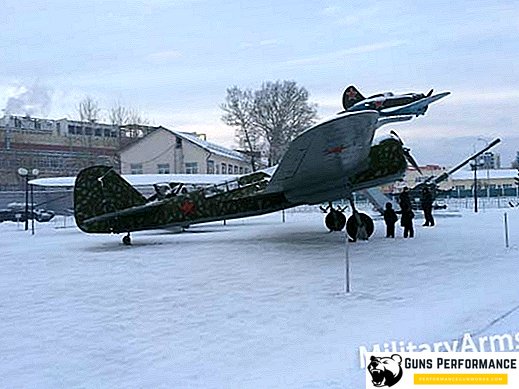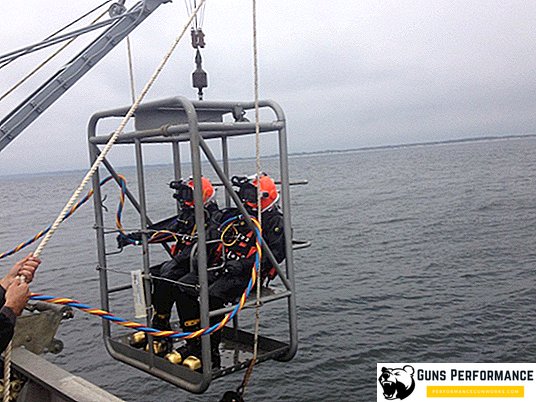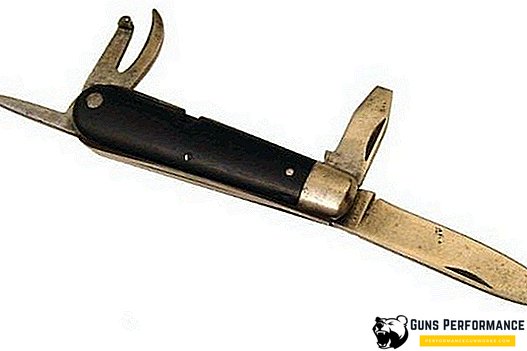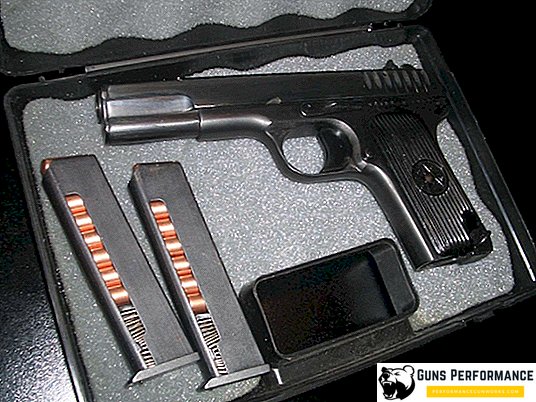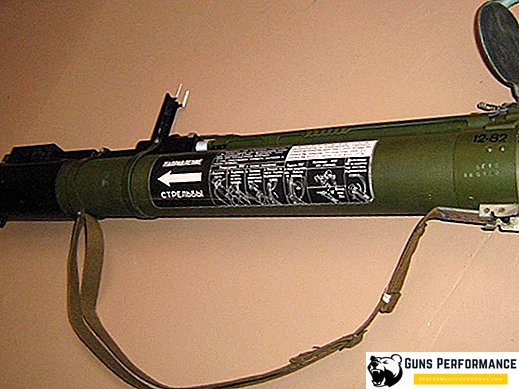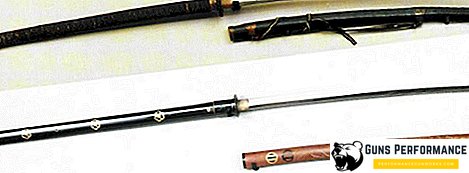
Nagamaki - a very unusual weapon. Translated from Japanese, nagamaks means “long wrapper”. This weapon is so unusual that experts still argue to which class it can be attributed. In appearance, the nagamaks very much resemble at the same time a spear to a naginat and nihonto's sword. Due to the fact that the blade and grip of nagamaks are of approximately the same length, it can be attributed to swords. Moreover, the manner of use was close to the technique of the katana. It is noteworthy that traditionally the highest quality steel was used to make nagamaks, because of which only rich hereditary samurai owned these weapons.
Although some sources nagamaki refers to the spears, it is fundamentally wrong. It is enough to know the traditional technique of Nagamak combat to make sure that it looks more like a sword technique. Due to the use of a long arm in the construction of this weapon, it is intended for delivering chopping blows, each of which was fatal. In the cramped nagamaks could be used as a spear, striking short piercing blows. This sword was used on foot, and the elite samurai infantry with nagaamaki could easily withstand the attacks of cavalry, in contrast to the infantry with traditional katanas. In this case, the length of the weapon allowed to strike the legs with the end, hemming them.
The origin of the nagamaki
Now it is not known exactly how such exotic weapons like nagamas appeared. There is a version that this is the evolution of the long Japanese sword "nodati. The length of the nagamaki blade is identical to the length of the katana blade. Although unlike the samurai sword, the length of the nagamaki was never regulated. The handle could be longer or shorter depending on the owner’s preference.
The main feature by which nagamas can be attributed to swords with confidence is the method of attaching the blade in the handle. It is attached to the pegs, just like a katana blade or a wakizashi. The handle itself was wrapped with a silk cord, copying the winding of the handle of a samurai sword. This type of winding made it possible to more confidently hold the handle in his hand, when, as a handle of a spear, it should allow hands to easily slide along the pole. Even the winding allowed to squeeze the handle more tightly, which excluded falling out of the already wedged blade in it.
In modern Japanese schools, where they study work with melee weapons, nagamas can also be found. Despite its rarity, the Japanese were able to preserve the traditions of owning this unusual sword.

Parameters and elements of nagamaki
Like any Japanese sword, nagamaki consists of several elements:
- Blade;
- Handle;
- Kasira or pommel;
- Manuki (decorative elements that are woven on both sides of the handle);
- Tsuba or garda;
- Habuki (analog of the forging on the blade of a knife).
The length of the blade of nagamas is about 60 centimeters, often the length could be longer (this depended on the physical parameters of the owner). The length of the handle is usually duplicated the size of the blade. The overall dimensions of the arms were from 120 to 220 centimeters. In each region, nagamas could differ from each other in length and weight. For example, the Araki-ryu school used nagamas with a total length of 2.4 meters, with a weight over 3.5 kilograms.
In the scheme of mounting the blade there was one difference from mounting the blade katana. He fastened not to one wedge, but to two or more. This is due to the size of the handle, which required a more secure attachment.
It is possible that nagamaks have been used since 794, although documentary sources only mention these weapons since 1192. The period of the Nambocutyo era (1334-1392 years) is the golden age for nagamas.

Detachments of samurai with nagamaki terrified the enemy. Huge swords operated at a great distance, not allowing the enemy to even come close to its owner. The traditional opponent of swordsmen - the cavalry, which easily managed to cope with ordinary swordsmen, suffered defeat in battles with troops armed with nagamas. This weapon could turn the course of the battle in their favor, disrupting the opponent’s entire strategy (for it is known that the cavalry is stronger than the swordsmen, but weaker than the spearmen, who in turn lose to the swordsmen).
Famous warlords using forces with nagamas
The most famous commanders of his time, not afraid to use unusual weapons, were Uesugi Kenshin (1530 - 1578) and Oda Nobunaga (1534-1582).
Uesugi Kenshin, who was the head (daimy) of Etigo province, specially trained the samurai squad to possess the nagamas, which more than once helped him out in battles.
Warriors Oda Nabunaga with nagamaki terrified only one of his appearance on the battlefield.
Japanese weapon related to nagamaki
There are two specific types of weapons that, despite external similarities with spears, are relatives of the nagamas, that is, they are more like swords.

Naginata, which many consider to be a Japanese spear, even literally translates as "long sword". Indeed, the work of naginata is very different from the work of another spear, jari. The naginaty handle has an oval cross section, while the arms of the copies have round cross sections. This feature allows you to easily fence a huge naginata (the length of which could be up to 2.5 meters). An experienced warrior with a naginata easily cracked down on several swordsmen or spearmen, beating their attacks and delivering his exact blows. The length of the weapon allowed to keep a safe distance for the owner.
Bisento is an even heavier kind of naginata. The difference between a bisento and a naginata is the special shape of the blade, which is intended for crushing chopping blows. Such weapons were owned only by physically strong warriors who used them against cavalry. An incredibly strong blow from a bisento knocks out a rider from a saddle, often already dead or incapable of resistance.

Making Namahaki do it yourself
Such specific weapons as nagamas can not be bought even in specialized stores. Blacksmiths, gunsmiths, too, with great reluctance to take on the unusual work. It remains to make this weapon by yourself or to help the blacksmith.
First you need to make a blade. Its parameters practically do not differ from the classic katana blade, only the shank should be longer. For the blade need carbon steel. Perfect 65g (spring) or y8 (it will be harder to get). You can simply forge a uniform blade of steel, or you can forge a blade with a soft core in a sheath of hard steel. The second option is much more difficult, but if an experienced blacksmith-Vilarmer forges, you can make such a blade.

Forged blade need to be processed to give the desired geometry. For this ideal grinding grinder. If not, you will have to use an electric sharpener. In order not to spoil the blade, you need to remove the extra metal very carefully. Final processing of the blade should be carried out with the help of a file. If you do not clean the file from clogging metal filings, you can deeply scratch the blade.
After shaping the blade, it needs to be hardened. Traditional Japanese hardening involves coating the blade with clay of a special composition. If you do not know the correct proportions, it is better to simply heat the blade and cool it by sharp immersion in a container with water.
After quenching, you need to make the release of the blade, otherwise it will be too fragile. The final processing of the blade includes sanding sanding. Next is the cutting of the dale on the blade. This can be done with the help of a grinder or a drill with abrasive nozzles. After that, the blade is finally ground to a mirror finish.
It is better to purchase Tsubu, Kasir and Manuk in advance, and the handle is not difficult to make from two dies of a suitable tree. In the dies, the groove for the blade shank is chosen, after which the halves are glued together and processed with a file to give shape.
The handle is pasted over with skin (it is better to use stingray skin, but a simple one will do) and after the glue dries, it is covered with a silk cord. When braiding you should not forget about manukah, which are embedded in the braid is not at all for beauty. In fact, their purpose is not to allow hands to slide on the handle.
After the handle is wrapped, we collect the sword, not forgetting about the correct sequence of all the structural elements.
If you wish, you can at the same time make the sheath for the namak. They are made of two wooden dies, inside which a blade groove is cut. After the groove is ready, the rugs are ground and glued together.
Sheath is given the desired shape, after which the outer side is also carefully polished and painted with black paint. Everything, your product is ready!
Nagamaki can be hung on the wall at home to give the room a unique Japanese surroundings. If you want to train with these weapons on the street, do not sharpen the cutting edge, otherwise it will be considered cold weapons.



